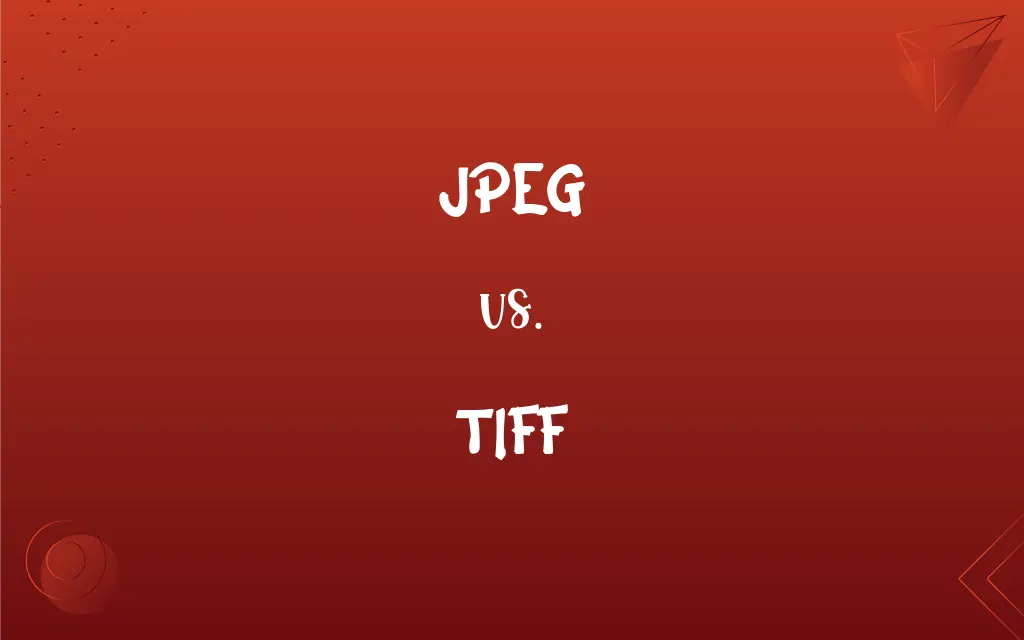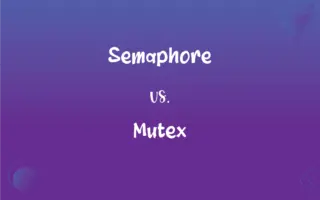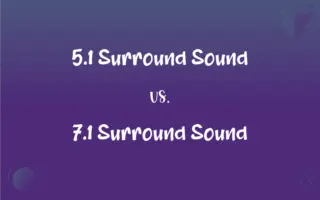JPEG vs. TIFF: What's the Difference?
Edited by Aimie Carlson || By Harlon Moss || Published on March 21, 2024
JPEG is a commonly used compressed image format ideal for web and digital use, while TIFF is a high-quality, uncompressed format often used in professional imaging.

Key Differences
JPEG (Joint Photographic Experts Group) is a popular image format known for its efficient compression, which reduces file size significantly but can result in loss of image quality. It is widely used for digital photography and online images due to its balance of quality and file size. In contrast, TIFF (Tagged Image File Format) is a flexible, uncompressed format that preserves image quality but results in larger file sizes. TIFF is preferred in professional environments like graphic design and photography where detail preservation is crucial.
JPEG images are best suited for the web and digital platforms where quick loading and efficient storage are key. This format uses lossy compression, meaning some image data is lost during compression, making it less ideal for repeated editing. On the other hand, TIFF offers lossless compression, ensuring no quality loss, which is vital in fields such as medical imaging, desktop publishing, and digital art where precision and detail are essential.
JPEG files are typically smaller and more manageable for sharing and uploading, making them the go-to choice for social media, email attachments, and websites. However, the compression can introduce artifacts, particularly in high-contrast areas. Conversely, TIFF files are larger and more robust, supporting multiple layers and channels, making them a preferred format in professional printing and digital archiving.
The JPEG format is not ideal for images requiring transparency or for those undergoing multiple edits and resaves, as the quality degrades each time. TIFF, however, maintains the integrity of the original image, supports transparency, and is better suited for extensive editing and archiving without quality degradation.
JPEG is universally compatible across devices and software, making it the most accessible image format for general use. In contrast, TIFF's high-quality features make it less universally supported, especially on web platforms, but it remains a standard in professional and commercial printing due to its detailed, high-resolution image preservation.
ADVERTISEMENT
Comparison Chart
Compression
Lossy, reduces file size but may lose quality
Lossless, preserves quality but results in larger files
Best Use
Web, digital use, and photography
Professional imaging, graphic design, printing
File Size
Smaller and more manageable
Larger, requiring more storage
Quality Preservation
Loses some quality in compression
Maintains original quality
Editing and Resaving
Not ideal for repeated editing due to quality loss
Suitable for multiple edits with no quality loss
ADVERTISEMENT
Transparency Support
Does not support transparency
Supports transparency
Universal Compatibility
Highly compatible across various devices and platforms
Less universally supported, especially on web
Preferred Professional Use
Used for digital photography and online sharing
Standard in professional printing and digital archiving
JPEG and TIFF Definitions
JPEG
JPEG is a popular image format with lossy compression.
I saved the photo as a JPEG to reduce its file size for email.
TIFF
It's preferred for detailed images in professional settings.
The magazine prints images only in TIFF format for clarity.
JPEG
JPEG is not ideal for images that require transparency.
I avoid using JPEG for graphics that need a transparent background.
TIFF
TIFF supports lossless compression, preserving original quality.
For medical imaging, we save files as TIFF to maintain detail.
JPEG
JPEG files can degrade in quality with repeated editing.
I noticed quality loss in the JPEG after several edits.
TIFF
TIFF files are larger and ideal for extensive editing.
I save my digital artwork as TIFF to avoid quality degradation.
JPEG
It's widely used for digital photography and online images.
All images on our website are in JPEG format for faster loading.
TIFF
TIFF is a high-quality, uncompressed image format.
We use TIFF format for archiving our professional photographs.
JPEG
JPEG is known for balancing image quality and file size.
For quick sharing on social media, I convert images to JPEG.
TIFF
TIFF is commonly used in professional printing and publishing.
Our graphic design team works exclusively with TIFF files for print.
JPEG
A standard algorithm for the compression of digital images.
TIFF
A fit of irritation.
JPEG
A digital image stored as a file so compressed
A JPEG of a cat.
TIFF
A petty quarrel.
JPEG
Alternative case form of JPEG
TIFF
To quarrel.
JPEG
A standardized format for storing graphic data in binary computer files, allowing over 16 million different colors. It allows for lossy compression, i. e. the compression of data into a form which re-expands into an image close, but not identical to the original image. Files stored in this format usually carry the extension jpg or jpeg. Compare GIF.
TIFF
A small argument; a petty quarrel.
TIFF
Liquor; especially, a small draught of liquor.
TIFF
(intransitive) To quarrel.
TIFF
To deck out; to dress.
TIFF
Liquor; especially, a small draught of liquor.
TIFF
A fit of anger or peevishness; a slight altercation or contention. See Tift.
TIFF
To be in a pet.
She tiffed with Tim, she ran from Ralph.
TIFF
To deck out; to dress.
TIFF
A quarrel about petty points
FAQs
When is TIFF preferred over JPEG?
In professional environments where image quality and detail are paramount.
Does JPEG support transparency?
No, JPEG does not support transparency.
What is JPEG?
A commonly used image format with efficient lossy compression.
Can JPEG files lose quality over time?
JPEG files can lose quality with repeated editing and resaving.
Is TIFF suitable for digital photography?
Yes, especially for high-quality prints and detailed editing.
Do JPEG images load faster than TIFF?
Yes, due to their smaller file sizes, JPEG images load faster.
Are TIFF files larger than JPEG?
Yes, TIFF files are typically larger due to their uncompressed nature.
Why choose JPEG over TIFF?
For smaller file sizes and widespread compatibility, especially online.
Can TIFF images be used on websites?
While possible, TIFF images are less common on websites due to their size.
Can TIFF files be easily shared online?
Due to their size, TIFF files are not as easy to share online as JPEGs.
What is TIFF?
A high-quality, uncompressed image format often used professionally.
Does TIFF maintain image quality after editing?
Yes, TIFF maintains high quality even after multiple edits.
Is JPEG suitable for quick web uploads?
Yes, JPEG is ideal for quick and efficient web uploads.
Is JPEG ideal for professional printing?
JPEG is less ideal for professional printing due to potential quality loss.
What are common uses for TIFF?
Professional imaging, graphic design, and high-quality printing.
Can TIFF format handle detailed graphics?
Yes, TIFF is excellent for detailed graphics and high-resolution images.
Is JPEG a good choice for archival purposes?
JPEG is less suitable for archival due to its lossy compression.
Which format is better for everyday photography?
JPEG is typically better for everyday, casual photography.
Are JPEG files universally compatible?
Yes, JPEG is one of the most universally compatible image formats.
Are TIFF files more secure for archival?
TIFF’s lossless nature makes it more secure for long-term archival.
About Author
Written by
Harlon MossHarlon is a seasoned quality moderator and accomplished content writer for Difference Wiki. An alumnus of the prestigious University of California, he earned his degree in Computer Science. Leveraging his academic background, Harlon brings a meticulous and informed perspective to his work, ensuring content accuracy and excellence.
Edited by
Aimie CarlsonAimie Carlson, holding a master's degree in English literature, is a fervent English language enthusiast. She lends her writing talents to Difference Wiki, a prominent website that specializes in comparisons, offering readers insightful analyses that both captivate and inform.































































